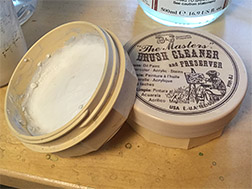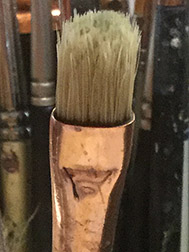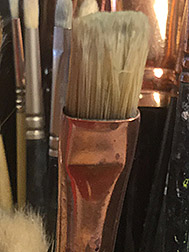
I believe in investing in good brushes. I know it’s a poor artist that blames their tools, but I’m annoyed by brushes with wild hairs sticking out this way or that, applying color everywhere but where I want it to go. As I’ve grown older, I’ve reluctantly learned to accept hair from my head in the sink, but I’ll be damned if I’m going to accept it falling from my paint brushes, when I clean them.
 Good brushes are expensive, so it makes sense to care for them properly, extending their life as long as is possible. When I was a kid, there weren’t any specialized products available for cleaning brushes, so the best choice was a bar of Ivory soap. Times have changed and today there are specialized products that not only aid in keeping your brushes clean, but also even condition the hair in your brushes. Two of the most popular are Speedball’s Pink Soap and my favorite, The Master’s Brush Cleaner and Conditioner.
Good brushes are expensive, so it makes sense to care for them properly, extending their life as long as is possible. When I was a kid, there weren’t any specialized products available for cleaning brushes, so the best choice was a bar of Ivory soap. Times have changed and today there are specialized products that not only aid in keeping your brushes clean, but also even condition the hair in your brushes. Two of the most popular are Speedball’s Pink Soap and my favorite, The Master’s Brush Cleaner and Conditioner.
Using the proper brush for the medium with which you’re working, I’ve learned, plays a huge role in brush life. If you’re painting with oils or watercolors, you can use either natural, synthetic or blended brushes. If you’re painting with acrylics, do yourself a favor and restrict yourself to synthetic brushes. Using natural hair brushes or even natural/synthetic blends with acrylics will quickly turn even the very best of these brushes to junk. I’ve learned this the hard way, through experience. If you’re painting with oils, you’ll get the best results with natural hair brushes, especially natural hair bristle brushes. They’ve yet to develop a synthetic bristle brush as stiff as a natural hog’s hair brush. A stiffer brush better moves paint in its fresh out of the tube consistency. With watercolors, purchase Kolinsky Sable brushes, if you can, otherwise buy the best synthetic sables you can afford.
Keep your acrylic brushes wet, at all times, when working with them. If you don’t, you won’t be able to get all the pigment our of your brushes, during your end of the day clean-up. Don’t leave them sitting in the water. Instead dip the hair of the brushes in the water from time to time, during your painting sessions, to keep them wet. Leaving them standing in water will loosen the hairs from the ferrules and break the paint down on the brush handles, causing it to crack and pop off, resulting in loose ferrules on the brush handles. Having to keep brushes wet is one of the reasons synthetic brushes are the best solution for acrylics, natural hair breaks-down, when kept wet all day.
I avoid dipping a completely dry brush into paint, first wetting it with the solvent or medium I’m using. With oils this is linseed oil, painting medium or turpentine (or an odorless substitute). With acrylics or watercolors this is just water. I believe this prevents the pigment from latching onto or being absorbed into brush hairs.
At the end of every painting session and I mean every painting session (don’t close the studio door and tell yourself you’ll deal with cleaning your brushes tomorrow), I first get my brushes as clean as I can with the solvent I’m using. I then use my brush cleaning product and clean my brushes until the soap foam being produced is no longer tinted with color, being sure to pay attention to the area where the hairs meet the ferrule (I gently squeeze the hairs between my thumb and finger here to get all the pigment out).

Lately I’ve adopted one last step to my brush care. I’m sure you’ve noticed how perfectly your brushes are shaped when you first bring them home from the art store. That’s because the manufacturers have dipped them into a soluble solution, prior to shaping them. This solution washes out with the first use, leaving even the best of brushes with a case of the frizzies. I’ve always done most of my own house painting. I’m cheap, have always known my way around paints and brushes and it’s difficult for me to hand over thousands of dollars to someone else, to do for me, what I can do myself. I’ve always wrapped my house painting brushes, after I’ve cleaned them, in newspaper or their original cardboard cases, if they came with them, to help the brushes maintain their original shape. It took hearing one or two others were doing this with their fine art brushes, for it to occur to me that this might be something good to try out. I’m now a convert!

With round brushes, while they’re still wet from my cleaning them with brush cleaning soap, I just shape them back to a point with my fingers. With flat brushes, however, while they’re still wet, I wrap them in thin cardboard, held in place with a small binder clip. I use cardboard from old cereal boxes, cut into strips a little wider than the distance from the bottom of the flat part of the ferrule to a little past the end of the brush hair. I leave the cardboard longer in length than what is needed to wrap around the brush, for easier handling. I use these cardboard strips over and over again on brushes of the same width. Through trial and error, you’ll be amazed how close you can get to achieving a shape similar to the one they had, when you brought them home from the art store.
 With proper care, brushes can live a long, useful life. I’m still working with some of the brushes I purchased back in art school!
With proper care, brushes can live a long, useful life. I’m still working with some of the brushes I purchased back in art school!

I like that article, I should really take your advise.
I’m more into watching for the Aaron Bros buy 1 brush get 2 free sale. I have discovered “Invisible Gloves” that I am loving. (when I remember to use it).
🙂 Thanks, Gina! “Invisible Gloves?” Is that a barrier cream you use on your hands that protects them from paint and makes paint wash off easily? If so, I use a similar product, “Winsor Newton’s ArtGuard,” when working with pastels to keep the pigment from penetrating my skin and still give me full use of my hands for blending, if I want. I used to use it when painting with oils or acrylics, but I’ve gotten used to wearing latex gloves, instead.
Thanks Bill! I’m going to give wrapping my brushes a try. It’s a great idea.
Great, Carolyn, give it a try. I’m still working on getting the perfect shapes, but I’m much happier with square edges I’m getting.